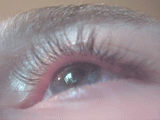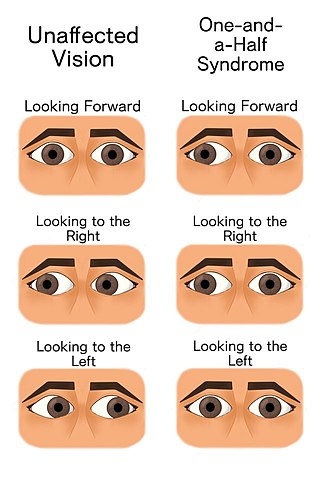Related Research Articles
Hemiparesis, or unilateral paresis, is weakness of one entire side of the body. Hemiplegia is, in its most severe form, complete paralysis of half of the body. Hemiparesis and hemiplegia can be caused by different medical conditions, including congenital causes, trauma, tumors, or stroke.

Botulinum toxin, or botulinum neurotoxin, is a highly potent neurotoxic protein produced by the bacterium Clostridium botulinum and related species. It prevents the release of the neurotransmitter acetylcholine from axon endings at the neuromuscular junction, thus causing flaccid paralysis. The toxin causes the disease botulism. The toxin is also used commercially for medical and cosmetic purposes.

Saliva is an extracellular fluid produced and secreted by salivary glands in the mouth. In humans, saliva is around 99% water, plus electrolytes, mucus, white blood cells, epithelial cells, enzymes, antimicrobial agents.

The salivary glands in many vertebrates including mammals are exocrine glands that produce saliva through a system of ducts. Humans have three paired major salivary glands, as well as hundreds of minor salivary glands. Salivary glands can be classified as serous, mucous, or seromucous (mixed).

The parotid gland is a major salivary gland in many animals. In humans, the two parotid glands are present on either side of the mouth and in front of both ears. They are the largest of the salivary glands. Each parotid is wrapped around the mandibular ramus, and secretes serous saliva through the parotid duct into the mouth, to facilitate mastication and swallowing and to begin the digestion of starches. There are also two other types of salivary glands; they are submandibular and sublingual glands. Sometimes accessory parotid glands are found close to the main parotid glands.

Xerostomia, also known as dry mouth, is dryness in the mouth, which may be associated with a change in the composition of saliva, or reduced salivary flow, or have no identifiable cause.

Parotitis is an inflammation of one or both parotid glands, the major salivary glands located on either side of the face, in humans. The parotid gland is the salivary gland most commonly affected by inflammation.

Glycopyrronium bromide is a medication of the muscarinic anticholinergic group. It does not cross the blood–brain barrier and consequently has few to no central effects. It is given by mouth, via intravenous injection, on the skin, and via inhalation. It is a synthetic quaternary ammonium compound. The cation, which is the active moiety, is called glycopyrronium (INN) or glycopyrrolate (USAN).
Hemifacial spasm (HFS) is a rare neuromuscular disease characterized by irregular, involuntary muscle contractions (spasms) on one side (hemi-) of the face (-facial). The facial muscles are controlled by the facial nerve, which originates at the brainstem and exits the skull below the ear where it separates into five main branches.

Blepharospasm is any abnormal contraction of the orbicularis oculi muscle. The condition should be distinguished from the more common, and milder, involuntary quivering of an eyelid, known as myokymia, or fasciculation. In most cases, blepharospasm symptoms last for a few days and then disappear without treatment, but in some cases the twitching is chronic and persistent, causing life-long challenges. In these cases, the symptoms are often severe enough to result in functional blindness. The person's eyelids feel like they are clamping shut and will not open without great effort. People have normal eyes, but for periods of time are effectively blind due to their inability to open their eyelids. In contrast, the reflex blepharospasm is due to any pain in and around the eye.

Spasmodic torticollis is an extremely painful chronic neurological movement disorder causing the neck to involuntarily turn to the left, right, upwards, and/or downwards. The condition is also referred to as "cervical dystonia". Both agonist and antagonist muscles contract simultaneously during dystonic movement. Causes of the disorder are predominantly idiopathic. A small number of patients develop the disorder as a result of another disorder or disease. Most patients first experience symptoms midlife. The most common treatment for spasmodic torticollis is the use of botulinum toxin type A.

The one and a half syndrome is a rare weakness in eye movement affecting both eyes, in which one cannot move laterally at all, and the other can move only in outward direction. More formally, it is characterized by "a conjugate horizontal gaze palsy in one direction and an internuclear ophthalmoplegia in the other". Nystagmus is also present when the eye on the opposite side of the lesion is abducted. Convergence is classically spared as cranial nerve III and its nucleus is spared bilaterally.

Oropharyngeal dysphagia is the inability to empty material from the oropharynx into the esophagus as a result of malfunction near the esophagus. Oropharyngeal dysphagia manifests differently depending on the underlying pathology and the nature of the symptoms. Patients with dysphagia can experience feelings of food sticking to their throats, coughing and choking, weight loss, recurring chest infections, or regurgitation. Depending on the underlying cause, age, and environment, dysphagia prevalence varies. In research including the general population, the estimated frequency of oropharyngeal dysphagia has ranged from 2 to 16 percent.

Sialadenitis (sialoadenitis) is inflammation of salivary glands, usually the major ones, the most common being the parotid gland, followed by submandibular and sublingual glands. It should not be confused with sialadenosis (sialosis) which is a non-inflammatory enlargement of the major salivary glands.

Frey's syndrome is a rare neurological disorder resulting from damage to or near the parotid glands responsible for making saliva, and from damage to the auriculotemporal nerve often from surgery.
Progressive bulbar palsy (PBP) is a medical condition. It belongs to a group of disorders known as motor neuron diseases. PBP is a disease that attacks the nerves supplying the bulbar muscles. These disorders are characterized by the degeneration of motor neurons in the cerebral cortex, spinal cord, brain stem, and pyramidal tracts. This specifically involves the glossopharyngeal nerve (IX), vagus nerve (X), and hypoglossal nerve (XII).
Hypersalivation or hypersialosis is the excessive production of saliva. It has also been defined as increased amount of saliva in the mouth, which may also be caused by decreased clearance of saliva.
Lytico-bodig (also Lytigo-bodig) disease, Guam disease, or amyotrophic lateral sclerosis-parkinsonism-dementia (ALS-PDC) is a neurodegenerative disease of uncertain etiology endemic to the Chamorro people of the island of Guam in Micronesia. Lytigo and bodig are Chamorro language words for two different manifestations of the same condition. ALS-PDC, a term coined by Asao Hirano and colleagues in 1961, reflects its resemblance to amyotrophic lateral sclerosis (ALS), Parkinson's disease, and Alzheimer's disease.

Amyotrophic lateral sclerosis (ALS), also known as motor neurone disease (MND) or Lou Gehrig's disease, is a rare and terminal neurodegenerative disease that results in the progressive loss of motor neurons that control voluntary muscles. ALS is the most common form of the motor neuron diseases. Early symptoms of ALS include stiff muscles, muscle twitches, gradual increasing weakness, and muscle wasting. Limb-onset ALS begins with weakness in the arms or legs, while bulbar-onset ALS begins with difficulty in speaking or swallowing. Around half of people with ALS develop at least mild difficulties with thinking and behavior, and about 15% develop frontotemporal dementia. Motor neuron loss continues until the abilities to eat, speak, move, or, lastly, breathe are lost.

Salivary gland diseases (SGDs) are multiple and varied in cause. There are three paired major salivary glands in humans: the parotid glands, the submandibular glands, and the sublingual glands. There are also about 800–1,000 minor salivary glands in the mucosa of the mouth. The parotid glands are in front of the ears, one on side, and secrete mostly serous saliva, via the parotid ducts, into the mouth, usually opening roughly opposite the second upper molars. The submandibular gland is medial to the angle of the mandible, and it drains its mixture of serous and mucous saliva via the submandibular duct into the mouth, usually opening in a punctum in the floor of mouth. The sublingual gland is below the tongue, on the floor of the mouth; it drains its mostly mucous saliva into the mouth via about 8–20 ducts, which open along the plica sublingualis, a fold of tissue under the tongue.
References
- ↑ Common Baby Teething Symptoms & Signs Kute Keiki. Retrieved on 2019-12-05
- ↑ Almeida, Cristiana; Almeida, Isabel; Vasconcelos, Carlos (2015). "Quality of life in systemic sclerosis". Autoimmunity Reviews. 14 (12): 1087–1096. doi:10.1016/j.autrev.2015.07.012. PMID 26212726.
- ↑ Weiss-Lambrou, R.; Tetreault, S.; Dudley, J. (1989). "The relationship between oral sensation and drooling in persons with cerebral palsy". American Journal of Occupational Therapy. 43 (3): 155–161. doi: 10.5014/ajot.43.3.155 . PMID 2735376 . Retrieved 2013-10-02.
- ↑ Kalf, J.G. (2009). "Prevalence and definition of drooling in Parkinson's disease: A systematic review". Journal of Neurology. 256 (9): 1391–1396. doi:10.1007/s00415-009-5098-2. PMC 2733191 . PMID 19288042.
- ↑ Ellies Maik (2004). "Reduction of salivary flow with botulinum toxin: Extended report on 33 patients with drooling, salivary fistulas, and sialadenitis". The Laryngoscope. 114 (10): 1856–1860. doi:10.1097/00005537-200410000-00033. PMID 15454785. S2CID 8507758.
- ↑ Lipp, A.; Trottenberg, T.; Schink, T.; Kupsch, A.; Arnold, G. (2003). "A randomized trial of botulinum toxin A for treatment of drooling". Neurology. 61 (9): 1279–1281. doi:10.1212/WNL.61.9.1279. PMID 14610139. S2CID 42377134 . Retrieved 2013-10-02.
- ↑ Mier, Richard J.; Bachrach, Steven J.; Lakin, Ryan C.; Barker, Tara; Childs, Judith; Moran, Maria (2000). "Treatment of Sialorrhea With GlycopyrrolateA Double-blind, Dose-Ranging Study". Archives of Pediatrics & Adolescent Medicine. 154 (12): 1214–8. doi: 10.1001/archpedi.154.12.1214 . PMID 11115305 . Retrieved 2013-10-02.
- ↑ "Definition of DROOL". www.merriam-webster.com. Retrieved 2020-06-13.
- ↑ "DROOL | meaning in the Cambridge English Dictionary". dictionary.cambridge.org. Retrieved 2020-06-13.